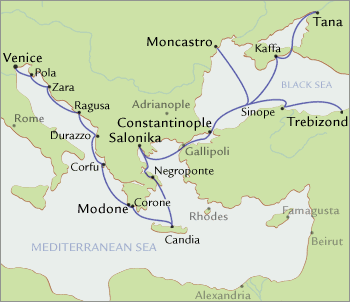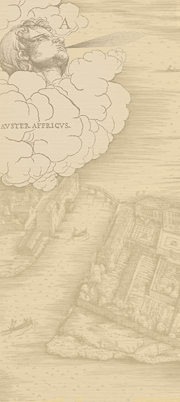Journey Map: Non-Flash Version

Galleys of Romania
Four or five galleys left Venice for the Black Sea in mid- to late June each year. They were expected back in in December after a journey of six months. The fleet stopped at Candia, Negroponte, Salonika, and Constantinople on the journey out and back
Points of Interest
Venice - Located on several islands in a protected lagoon at the head of the Adriatic, Venice was a republic, ruled by its noble families and an elected doge. Halfway between the eastern and western ends of the Mediterranean, it thrived as a trading emporium for goods moving in both directions, as well as over the Alps to Northern Europe.
Michael came to Venice in 1401. He left every year in the war galleys of the Venetian navy or the merchant galleys of the commercial fleet.
Modone - Modone (ancient and modern Methone) was one of Venice's most important naval bases, guarding the entrance to the Adriatic. Almost all Venetian galleys called at Modone en route to their destination and again on their return to Venice.
In 1403, Michael witnessed the carnage of a sea battle fought against the Genoese by the Venetian fleet near Modone.
Michael likely visited Modone on almost every voyage he made to the east, and almost every time he served in the Guard.
Salonika - The Byzantine Empire's second largest city, Salonika (also known as Thessalonica) derived its wealth from its rich agricultural hinterland. Byzantine Despot Andronikus Palaeologus sold the city to Venice in 1423. It remained in Venetian hands until captured by Ottoman ruler Murad II in 1430.
Michael fought in and around Salonika as comito in 1424 and 1425, and as armiraio in 1428 and 1429. He also visited Salonika on commercial voyages to the Black Sea as comito in 1421, 1426, and 1427.
Constantinople - Constantinople controlled access to the Black Sea and was a major commercial crossroads between Europe and Asia. The city remained the capital of the Byzantine Empire until it was captured in 1453 by the Ottoman Turks, who gave it its modern name of Istanbul.
Michael visited the vast city at least seven times, usually with galleys of Romania. He sailed on special missions as comito in 1437 and homo de conseio in 1439, bringing Byzantine Emperor John VIII to Italy and back.
Moncastro - Located at the mouth of the Dniester River, this city was the natural outlet for the rich goods and produce of the Ukraine.
Goods traded for here included furs, skins, honey, grain, and iron.
This destination was used by the Venetians for only a few years. Michael voyaged here once as homo de conseio in 1435.
Tana - This ancient city in the north east corner of the Black Sea marked the western end of a major trade route extending all the way across Asia to China. Although Tana changed rulers several times, it was dominated by the Venetian and Genoese merchants who settled and traded there.
In Michael's time, the main goods traded for at Tana included slaves, furs, grain, and salt fish.
Michael voyaged to Tana three times, as comito in 1421, 1427 and 1439.
Trebizond - The Empire of Trebizond was formed from the wreckage of the Byzantine Empire after the capture of Constantinople by Latin crusaders, with the help of Venice, in 1204. Located at the end of a caravan route leading all the way through Asia to China, it was controlled by descendents of earlier Byzantine emperors.
Goods traded for here included silk, drugs, jewels, and metals.
Michael voyaged to Trebizond once as comito in 1426.











